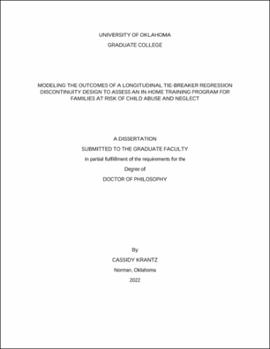| dc.description.abstract | The current study examined the treatment effects of a newly adapted in-home training program for families at risk of child abuse and neglect. In-home interventions for child abuse and neglect have proven effective for reducing risk in low to mid-risk families, but high-risk families are underserved and have a pattern of high recidivism post-treatment. This study compared the standard training (Services as usual; SAU) to the new program, SafeCare+ (SC+), for impact on three different predictors of risk: depression, social support, and access to resources. Subjects were assigned using a tie breaker regression discontinuity design (LTBRDD) which allowed for experimental and ethical outcomes. Multilevel piecewise growth modeling was employed to capture pre-treatment, post-treatment, and follow-up data nested within subjects so that differences in treatment, assignment method, and change in time could all be modeled. Significant moderator effects of treatment on slope in two of the three outcomes, depression and social support, supported the hypothesis that SC+ recipients experience greater positive change in risk factors than SAU recipients. This significant treatment effect on slope also indicated a continued growth from post-treatment to follow-up, supporting the efficacy of SC+ to not lead to high recidivism. Due to the complexity of the design, there is not much in the literature to guide analytic procedures for LTBRDD, so future research should test, compare, and validate different analytic methods to make this design more approachable. | en_US |
